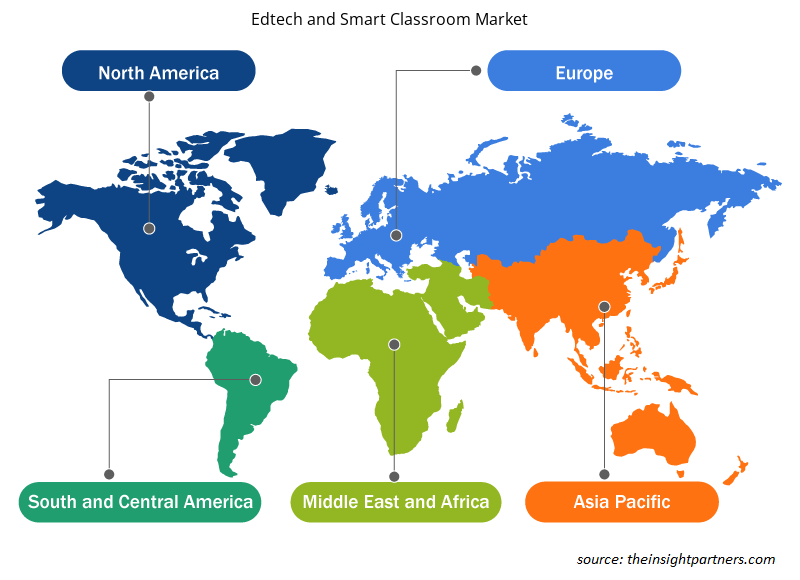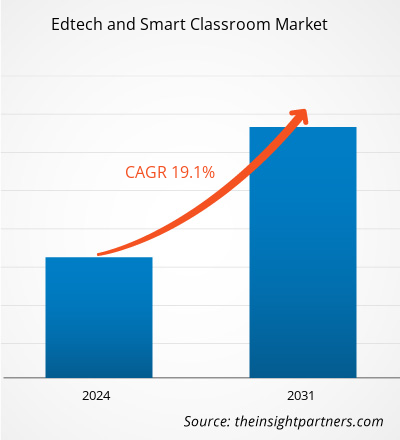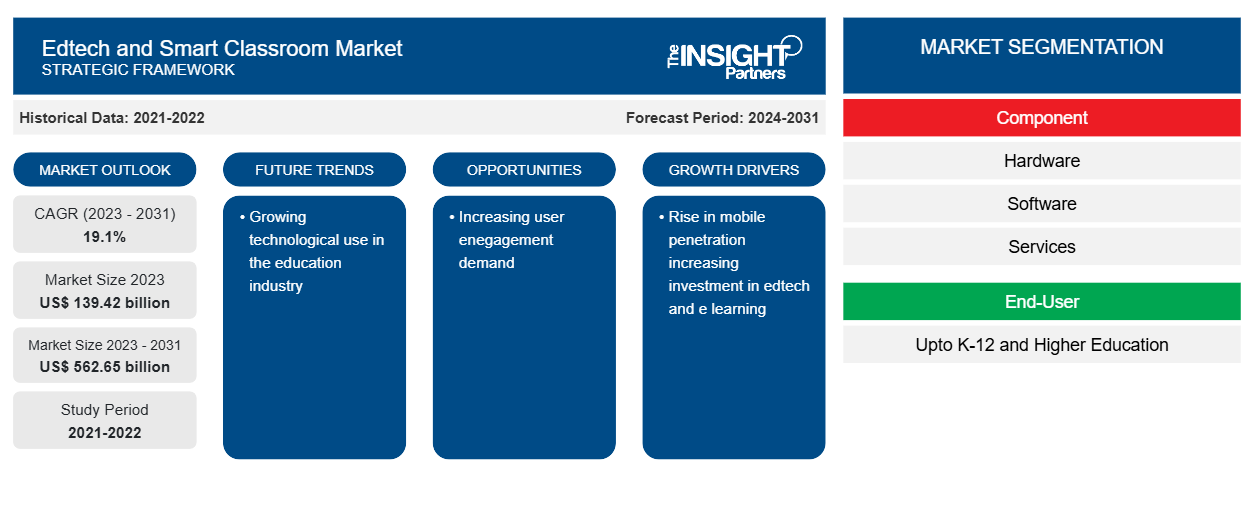教育科技和智能教室市场规模预计将从 2023 年的 1394.2 亿美元增长到 2031 年的 5626.5 亿美元;预计从 2023 年到 2031 年的复合年增长率为 19.1%。教育行业技术应用的不断增长可能仍是教育科技和智能教室市场的关键趋势。
教育科技与智能教室市场分析
由于人们越来越重视数字课程规划和远程学习,IT 系统(尤其是基于云的平台)比以往任何时候都更加重要。云可能是一种鼓励用户转型的技术创新。通过使用远程服务器、网络、数据库系统、分析、存储系统、软件和其他数字资源,云计算是一种通过互联网提供计算服务的信息技术范例。对于高等教育,云计算提供了巨大的优势,尤其是对于 K-12 大学生。通过在课堂上利用云计算,教育工作者可以毫不费力地进行虚拟课程,并让学生参与各种在线作业和课程。因此,虚拟课程的使用日益增多,推动了 教育技术和智能教室市场的增长
教育科技和智能教室市场概览
云是使用最广泛的技术,因为它具有灵活的存储和使用方法、强大的安全功能以及易于使用。教育工作者可以利用云进行低成本的在线学习、文件共享以及以各种格式存储大量文件。正因为如此,几乎所有的教育科技企业和教育机构都倾向于使用云。通过游戏化学习是另一种创新时尚。关于 教育技术,传统的教育方法很费力,需要高度集中的游戏化;然而,它们将学习变成了一种愉快的活动。通过游戏化,学生可以与计时器或彼此竞争,在排行榜上实时查看他们的进度,并获得高分奖励。对于今天的用户来说,这增加了学习的兴奋感和乐趣。许多重要的公司已经将游戏化作为一种营销趋势来响应这种教育科技和智能教室趋势。
定制此报告以满足您的需求
您可以免费定制任何报告,包括本报告的部分内容、国家级分析、Excel 数据包,以及为初创企业和大学提供优惠和折扣
-
获取此报告的关键市场趋势。这个免费样品将包括数据分析,从市场趋势到估计和预测。
教育科技和智能教室市场驱动因素和机遇
移动普及率上升有利于市场增长
低收入人群的移动普及率最高。萨珀斯坦称,AT&T 已提供 1 亿美元,为低收入和农村地区的 5 万名学生提供移动连接和设备。印度是世界第二大人口大国,人口为 180 亿(世界银行),到 2024 年可能超过中国成为人口最多的国家(联合国报告)。
此外,印度是人口结构最年轻的国家之一,18 至 34 岁年龄段的印度人口占总人口的近 30%,学龄儿童人数为 2.6 亿。Project Tomorrow 报告指出,截至 2022 年,33% 的美国高中生和 31% 的初中和小学生拥有学校发放的移动设备。由于移动设备的广泛使用,游戏化、虚拟教室和电子学习正在兴起,推动了教育科技和智能教室市场的增长。
教育科技与智能教室市场报告细分分析
促成教育科技和智能教室市场分析的关键部分是组件和最终用户
- 根据组成部分,教育科技和智能教室市场分为硬件、软件和服务。
- 根据最终用户,教育科技和智能教室市场细分为 K-12 和高等教育。
教育科技和智能教室市场份额按地区分析
- 教育科技和智能教室市场分为五大区域——北美、欧洲、亚太地区 (APAC)、中东和非洲 (MEA) 以及南美和中美。预计亚太地区在预测期内的复合年增长率最高。
- 过去几年,中国在信息通信技术基础设施和教育资源方面投入了大量资金,推动了技术与教育的融合。近年来,在线学习在中国越来越受欢迎。在线学习的用户越来越普遍。例如,该地区提供许多在线学习系统,包括在线学习、VIPKid 和一个为 4 至 15 岁中国儿童提供一对一英语课程的教育平台。自 1990 年代在线学习首次出现以来,政府通过实施许多政策,非常重视其发展。因此,该地区在在线学习领域取得了巨大成就,推动了教育科技和智能教室市场的增长。
教育科技和智能教室市场区域洞察
Insight Partners 的分析师已详细解释了预测期内影响教育科技和智能教室市场的区域趋势和因素。本节还讨论了北美、欧洲、亚太地区、中东和非洲以及南美洲和中美洲的教育科技和智能教室市场细分和地理位置。

- 获取教育科技和智能教室市场的区域特定数据
教育科技和智能教室市场报告范围
| 报告属性 | 细节 |
|---|---|
| 2023 年的市场规模 | 1394.2亿美元 |
| 2031 年市场规模 | 5626.5亿美元 |
| 全球复合年增长率(2023 - 2031) | 19.1% |
| 史料 | 2021-2022 |
| 预测期 | 2024-2031 |
| 涵盖的领域 |
按组件
|
| 覆盖地区和国家 |
北美
|
| 市场领导者和主要公司简介 |
|
教育科技和智能教室市场参与者密度:了解其对业务动态的影响
由于消费者偏好的不断变化、技术进步以及对产品优势的认识不断提高等因素,最终用户需求不断增加,推动了教育科技和智能教室市场快速增长。随着需求的增加,企业正在扩大其产品范围,进行创新以满足消费者需求,并利用新兴趋势,从而进一步推动市场增长。
市场参与者密度是指在特定市场或行业内运营的企业或公司的分布情况。它表明在给定市场空间中,相对于其规模或总市场价值,有多少竞争对手(市场参与者)存在。
在教育科技和智能教室市场运营的主要公司有:
- 苹果公司
- 黑板公司
- 思科系统公司
- D2L 公司
- IBM 公司
- 联想集团有限公司
免责声明:上面列出的公司没有按照任何特定顺序排列。

- 了解教育科技和智能教室市场顶级关键参与者概况
教育科技和智能教室市场新闻和最新发展
通过收集一手和二手研究后的定性和定量数据来评估点对点保险市场,其中包括重要的公司出版物、协会数据和数据库。以下是教育科技和智能教室市场的发展列表:
- 2022 年 7 月,Blackboard Inc. 宣布发布 Blackboard Data 平台的报告层,该平台将向机构提供报告,旨在提供有关 Blackboard SaaS EdTech 生态系统中学习工具使用情况的看法。
(来源:Blackboard Inc,新闻稿)
- 2022 年 9 月,思科推出了 Webex Classrooms,无论教师、学生和家长身处何处,它都可以安全地连接在一个区域内。
(来源:思科,新闻稿)
教育科技和智能教室市场报告覆盖范围和交付成果
“教育科技和智能教室市场规模和预测(2021-2031)”对市场进行了详细的分析,涵盖了以下领域:
- 范围内所有主要细分市场的全球、区域和国家层面的市场规模和预测
- 市场动态,如驱动因素、限制因素和关键机遇
- 未来的主要趋势
- 详细的 PEST/波特五力分析和 SWOT 分析
- 全球和区域市场分析涵盖关键市场趋势、主要参与者、法规和最新市场发展
- 行业格局和竞争分析,涵盖市场集中度、热点图分析、知名参与者和最新发展
- 详细的公司简介
- 历史分析(2 年)、基准年、预测(7 年)及复合年增长率
- PEST和SWOT分析
- 市场规模、价值/数量 - 全球、区域、国家
- 行业和竞争格局
- Excel 数据集
近期报告
客户评价
购买理由
- 明智的决策
- 了解市场动态
- 竞争分析
- 客户洞察
- 市场预测
- 风险规避
- 战略规划
- 投资论证
- 识别新兴市场
- 优化营销策略
- 提升运营效率
- 顺应监管趋势























 获取免费样品 - 教育科技和智能教室市场
获取免费样品 - 教育科技和智能教室市场